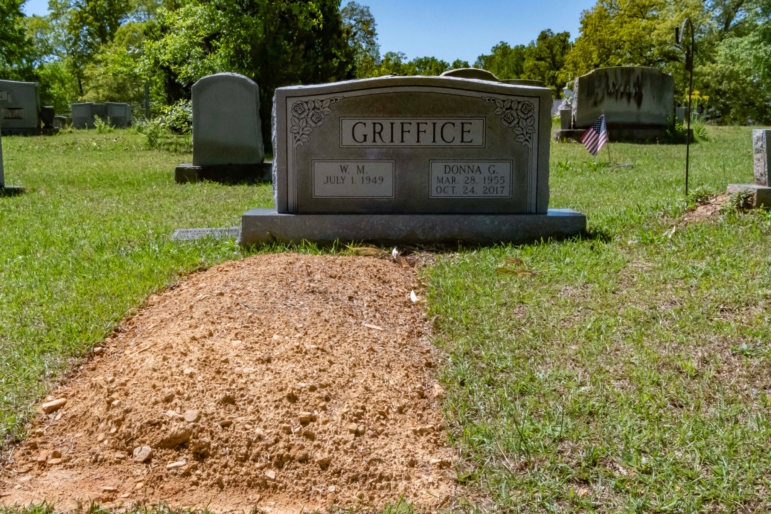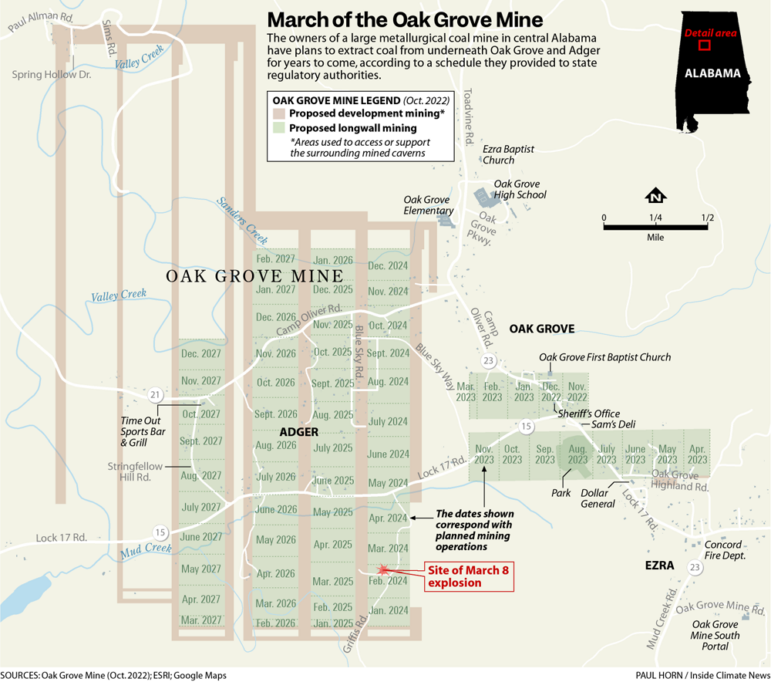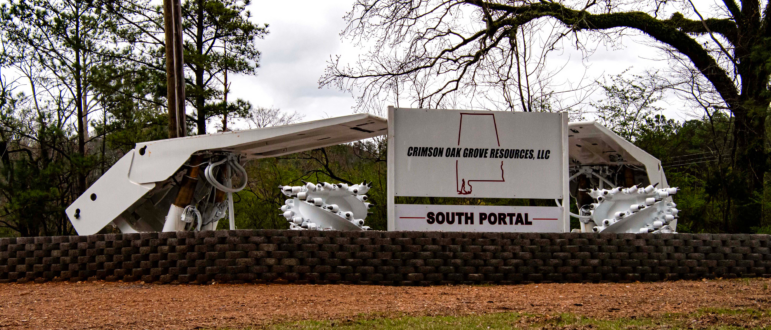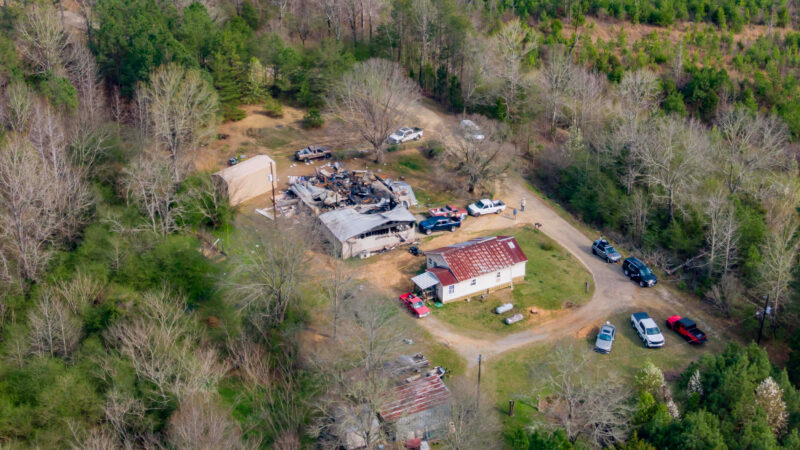Coal regulators said they didn’t know who’d bought a mine linked to a home explosion. It’s a familiar face
The Griffice family's home that exploded in Adger is one of more than a hundred that Oak Grove Mine operators have said could be impacted by subsidence.
This article originally appeared on Inside Climate News, a nonprofit, independent news organization that covers climate, energy and the environment. It is republished with permission. Sign up for their newsletter here.
By Lee Hedgepeth, Inside Climate News
OAK GROVE, Ala.—New ownership at an Alabama mine accused of causing a fatal home explosion earlier this year is raising old concerns for residents in rural Jefferson County, less than an hour’s drive outside Birmingham.
There, the rumors about the sale run as deep as the coal seam, and Alabama mine regulators have so far told residents nothing about it.
The new owner’s identity emerged this week only when Ryan M. Murray, son of late coal magnate and Donald Trump ally Robert Murray, said in a post on social media that he is now serving as president and chief operating officer of Oak Grove mine. His post was the first public sign of leadership change inside Oak Grove.
So far, public records including regulatory and property records do not reflect any shift in ownership, but the website of American Consolidated Natural Resources (ACNR), the mine’s prior owner, no longer lists the facility on its operations portfolio. In a statement, a United Mine Workers official also confirmed that miners had been made aware of the sale, though mine officials did not reveal the buyer’s identity at the time. Contracts with miners are expected to be honored by any new ownership, the union officials said.
The Murray family is not unfamiliar with the central Alabama mine. Murray Oak Grove Coal LLC owned the facility from April 2019 to September 2020, according to federal mine records. ACNR, a company that emerged from the bankruptcy of Murray Energy, owned the mine from then until the current sale.
Under those months of Murray Energy ownership, Oak Grove mine racked up more than 300 safety violations, more than 100 of which were considered “significant and substantial” by federal regulators.
Ryan M. Murray worked for Murray Energy for years, according to his LinkedIn, serving in roles from laborer to general manager before becoming vice president of operations. In 2021, he founded Murray Mining LLC, a company focused on project management, contract mining and consulting. The profile now lists Murray as president and COO of an entity called “Oak Grove,” which is listed on the site as a “supplier of metallurgical coal.”
Murray and Oak Grove have not yet responded to requests for comment.
Lily Spicer, typical of Oak Grove residents whose homes sit above the expanding longwall coal mine, said she simply wants to know who now owns the mine accused of killing her neighbor in a home explosion.
It was one of the reasons she traveled to Jasper, Alabama, to the second floor of a bank where the state’s mining regulator met earlier this month. She wanted to ask members of the state’s surface mining commission about issues she felt they should have addressed months ago, before W.M. Griffice’s home exploded in March, leaving him dead and his grandson severely injured. The blast shook the foundation of Spicer’s home, the flames from the resulting blaze lighting up the sky above the treeline.
Spicer said the meeting provided few answers and little relief. Instead, she and other residents are still left in the dark, wondering what a new owner might mean for their safety and future.
“They’re guarding it like a national security secret,” Spicer said.
Now she’s fed up. On an Alabama summer day, she walked around her house to point out cracks in its foundation she said were caused by the expanding mine. She had on a T-shirt with a cat and a firm message in a friendly font: “Fluff around and find out.”
Earlier this year, methane gas from the same underground mine that caused the damage at her home led to the explosion that killed her elderly neighbor, Griffice, and severely injured his grandson, according to their family’s lawsuit.

Since that explosion, Spicer has spent much of her time worrying. Mine officials have done little to assuage her fears that she, too, may soon fall victim to the dangers of longwall mining, an extractive process where coal is scraped from vast underground seams, releasing methane gas into the rock, creating caverns that often cause the land above to sink.
The regulators charged with permitting mines in the state told Inside Climate News last week that while they knew a sale of the mine had occurred, they were unaware of the buyer’s identity. Despite that uncertainty, coal operations could be expected to continue undisturbed under new ownership, the Alabama Surface Mining Commission’s director said in response to questions.
For Spicer and other residents, the changes at Oak Grove mean a moving goalpost. Before the sale, she was skeptical that anyone would ever be held accountable for her community’s losses, she said. Now, she seems almost sure of it.
“It’s another manipulative blurring of the truth, and things will continue as they always have been,” Spicer said.

The prior owner had become the largest privately-owned coal operator in the U.S. when it emerged from the Murray Energy bankruptcy in 2020, just months before Robert Murray died from complications caused by idiopathic pulmonary fibrosis, a lung condition, at age 80. Prior to his passing, Murray applied for black lung benefits from the U.S. Department of Labor, suggesting his condition was caused by his work inside coal mines, which he’d previously denied.
Murray had been an outspoken critic of environmental regulation of the fossil fuel industry, often appearing on outlets like Fox Business to decry the regulatory state that he said had a stranglehold on coal production.
Murray Energy, the Ohio-based company he founded, became the center of national controversy in 2007 when six miners were trapped inside the Crandall Canyon mine in Utah following a collapse. Prior to that incident, the mine had received 64 violations and $12,000 in fines. In its wake, regulators with the federal Mine Safety and Health Administration fined various entities a total of $1.85 million over the tragedy, its largest penalty ever.
Around the same time, while his company spiraled into bankruptcy, Robert Murray was funding climate change denial propaganda, according to reporting by The New York Times.
“The company gave $300,000 to Government Accountability & Oversight, a group focused on countering organizations that oppose Trump administration environmental rollbacks,” a Times investigation concluded. “An additional $200,000 went to the Competitive Enterprise Institute, a free-market think tank that maintains that scientists have not proven that human activity is the main cause of rising emissions. And $130,000 was given to the Heartland Institute, which has sponsored climate-change deniers to speak at United Nations climate change conferences.”
Robert Murray’s policy preferences, which largely center around the deregulation of the fossil fuel industry, gained a foothold in the White House under President Trump, to whom the coal baron had contributed significantly.
Ryan M. Murray, now the head of Oak Grove, has also contributed to the Trump Victory fund and other right-wing causes through political action committees, including that of ACNR, according to campaign finance records.

In and around Oak Grove, support for the former president is widespread, but residents of the rural community have also said that Republican or Democrat, underground mining causes your home to sink just the same.
It’s money, they said, that keeps regulators and public officials from acting decisively to protect their community.
Spicer said no matter who owns Oak Grove mine, she plans to keep up the pressure on mine and public officials: Residents shouldn’t have to live in fear of an explosion or a sinking home. There’s always the temptation of a clean start, she said, but with rising home prices elsewhere and a current property located next to the site of a home explosion, even that seems like an impossibility. A new mine owner, she said, won’t change any of that.
“It’s probably just a new shade of lipstick on the pig,” she said.
James Bruggers contributed reporting for this story.
Viral global TikToks: A twist on soccer, Tanzania’s Charlie Chaplin, hope in Gaza
TikToks are everywhere (well, except countries like Australia and India, where they've been banned.) We talk to the creators of some of the year's most popular reels from the Global South.
This painting is missing. Do you have it?
An important work from a rediscovered artist has been absent from public view since the 1970s. A New York curator is hunting for it.
Memory loss: As AI gobbles up chips, prices for devices may rise
Demand for memory chips currently exceeds supply and there's very little chance of that changing any time soon. More chips for AI means less available for other products such as computers and phones and that could drive up those prices too.
Brigitte Bardot, sex goddess of cinema, has died
Legendary screen siren and animal rights activist Brigitte Bardot has died at age 91. The alluring former model starred in numerous movies, often playing the highly sexualized love interest.
For Ukrainians, a nuclear missile museum is a bitter reminder of what the country gave up
The Museum of Strategic Missile Forces tells the story of how Ukraine dismantled its nuclear weapons arsenal after independence in 1991. Today many Ukrainians believe that decision to give up nukes was a mistake.
Jeffrey R. Holland, next in line to lead Church of Jesus Christ of Latter-day Saints, dies at 85
Jeffrey R. Holland led the Quorum of the Twelve Apostles, a key governing body. He was next in line to become the church's president.









